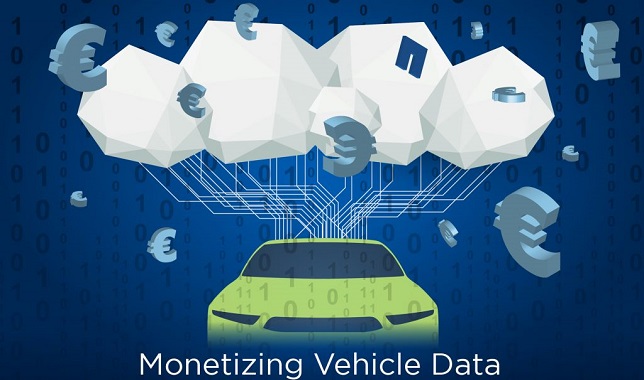The Big Opportunity – Vehicle Data Monetization

New Business Adjacencies for Car Manufacturers
Conventionally, OEMs generate the majority of their revenue through sales of vehicles and aftermarket services. However, new revenue streams are emerging as car manufacturers invest in new business models such as mobility-as-a-service and vehicle-as-a-platform.
On average, conventional businesses account for over 90% of revenue generated by manufacturers. However, by 2035, this share is expected to shrink to about 70% as new business models gain traction. Mobility-as-a-service has witnessed rapid growth in the past five years through services such as ride sharing, ride hailing, and subscription.
Vehicle-as-a-platform is a relatively new concept with less than one 1% share in total automotive revenue. However, this segment is expected to grow to 7% by 2035 (1.3x growth year-on-year), making it the fastest growing business model. This business segment is categorized by two revenue streams: data monetization and platform-as-a-service.
Europe and the US are currently leading the data monetization landscape. On the other hand, in markets such as India, the opportunity is still in the early stages, with major focus on infrastructure development for connected technology.
Data Generation: Tapping New Revenue Streams
Data is a direct byproduct of connected technology, and given technological advancement, several companies in India are eager to tap the potential opportunity.
Five key entities are working toward development of the market.
- Government: The Indian government and several agencies are recognizing the value of data and implementing various programs that allow private companies to utilize data to create business value. AIS 140 mandate, bulk data sharing policy, IRDAI’s provision for usage-based insurance (UBI), and proposal for ease of access to satellite remote sensing data are some of the recent initiatives undertaken by the government.
- OEMs: In 2019, less than 5% of new cars had connected features, and now that number has increased to over 15%. Both car and two-wheeler manufacturers are recognizing the opportunity and launched over 25 new models with several connected capabilities. Hyundai, Suzuki, Tata, and Hero are a few prominent manufacturers that have introduced connected technologies in their vehicles.
- Telecom companies: Communication is crucial to facilitate data collection; hence, telecom companies such as Vodafone Idea, Airtel, and Jio have developed solutions for automotive IoT. Vodafone is leading the market with major partnerships with Hyundai, Suzuki, and Mahindra, to name a few. Airtel recently announced a partnership with Morris Garages.
- Data aggregation: Companies such as Rollr, Here Technologies, C.E. Info Systems Pvt Ltd (MapmyIndia), and Deduce Technologies are providing platforms that enable collection, storage, and analysis of data.
- Hardware providers: From infotainment system manufacturers to telematics hardware suppliers, companies are developing products with 4G and 5G capability for data communication.
The data analyzed is being used by several customer segments such as OEM, insurance, banking and finance, e-commerce, media, and advertisement.
Data Utilization Models
There are two broad applications of data:
- Indirect monetization: Data analysis is important to improve the overall efficiency of business performance, which results in indirect realization of revenue generated.
For instance, to enhance supply chain efficiency through predictive maintenance, several OEMs have developed inhouse algorithms that predict potential component failure through data analysis. This data is relayed across the supply chain to ensure parts availability, optimize inventory, schedule repair services, and even facilitate payment or insurance.
Use cases include fleet telematics, insurance, financial services, diagnostics, supply chain solutions, connected driving, autonomous solutions, urban mobility, dealerships, among others.
- Direct monetization: Another key application, which is relatively new in the market, is the direct sale of data collected. In these cases, data is directly sold to end-use customer segments.
New-age companies such as Otonomo and Wejo are gaining popularity by developing robust use cases that deliver value for enterprises through analysis of data collected by OEMs.
For instance, location-based data from vehicles is used by companies such as MapmyIndia to develop insights on traffic, and several players use these solutions to plan their logistics and warehousing. Such data is also utilized by government agencies to plan infrastructure projects.
Use cases include driver/rider profiles, media & advertisements, maps & navigations, smart cities, geo-spatial analysis, traffic solutions, among others.
While companies have developed a substantially robust process for indirect monetization, the direct monetization model is still in the early stages. Globally, Western Europe, followed by the US, has made inroads in terms of developing and testing several use cases.
In India, indirect data monetization is gaining considerable popularity, creating many opportunities over the last few years. For instance, IRDAI allowed UBI under its Regulatory Sandbox, enabling companies such a TATA AIG to launch AutoSafe (UBI). This has also prompted several firms to offer cloud-based data management, storage, and transfer solutions.
However, for the market for direct monetization is in nascent stage, with limited use cases and few partnerships.
Key Use Cases Currently Monetized in India
Asset monitoring: At present, asset monitoring is largely undertaken by commercial vehicle fleet owners and banks. Fleet owners’ avail of short- and mid-term loans from banks for purchasing/leasing vehicles for logistics and distribution purposes. A key challenge for the banks is to evaluate the potential return on their investments and the risks associated.
Real-time and historic data of vehicle location and odometer readings, among others, helps banks run an algorithm that defines the potential returns and tracks non-performing assets (which are seized in case the company defaults on loan payments).
Insurance: Insurance claim fraud is increasing in India. For vehicles alone, 90% of frauds are due to padding claims (adding vehicle damages, injuries, and fictitious passengers to claims). Therefore, data-driven collision analysis can help companies accurately determine the potential cost of repair and reimbursement.
Such connected features reduce the claim cycle time and increase the overall process efficiency, which in turn adds value to businesses and consumers.
Traffic: Companies such as MapmyIndia purchase real-time location and velocity/speed data from data-generating companies including OEMs and fleet owners. The data points are analyzed to track traffic flow and develop specific use cases.
Traffic information is made available via traffic APIs, using which customers can develop tailored solutions for their businesses. For instance, users can relay traffic details for a specific route along with alternate routes to logistic fleets in order to improve their fuel efficiency and delivery time.
Potential Market Size and Conclusion
For OEMs, the key opportunity is in indirect monetization that adds value to consumers or end users through solutions, this directly results in a stronger brand and increased revenue. Revenue generated through direct monetization is relatively low and mainly aimed to recover infrastructure costs.
For data aggregator companies there are two key opportunities, data analytics, and software as a service. Data analytics is done through software which are predominantly designed with machine learning, Big Data, and artificial intelligence. These software are also offered to companies for their data processing and provide additional sources of revenue.
The Indian market for vehicle data monetization is expected to grow exponentially to reach over USD 500 million by 2025. Revenue is a product of average revenue generated per vehicle per month and number of vehicles. Manufacturers can develop robust monetization models to generate revenues of up to USD 5 per vehicle each month.
However, there are three key aspects to consider:
- It is important to design a robust infrastructure to develop suitable solutions. In addition, strategic deployment of technology such as narrowband and massive IoT is critical for a sustainable revenue stream.
- It is crucial to identify partners for realizing the full potential of revenues offered by data monetization.
- It is vital to identify opportunities for data synergies to discover new business cases.
Author:

Vishal Sanghavi
Senior Manager – Strategy Consulting (Automotive & Mobility)
Aranca
Vishal heads the automotive practice at Aranca, a global business research & advisory firm. A thought leader with over 13 years of consulting experience in the automotive industry, Vishal has a demonstrated track record in developing successful growth strategies for players across the value chain. Vishal is a passionate mobility futurist and works with clients to help them position for the future in view of the disruption caused by the CASE trends.
Published in Telematics Wire

